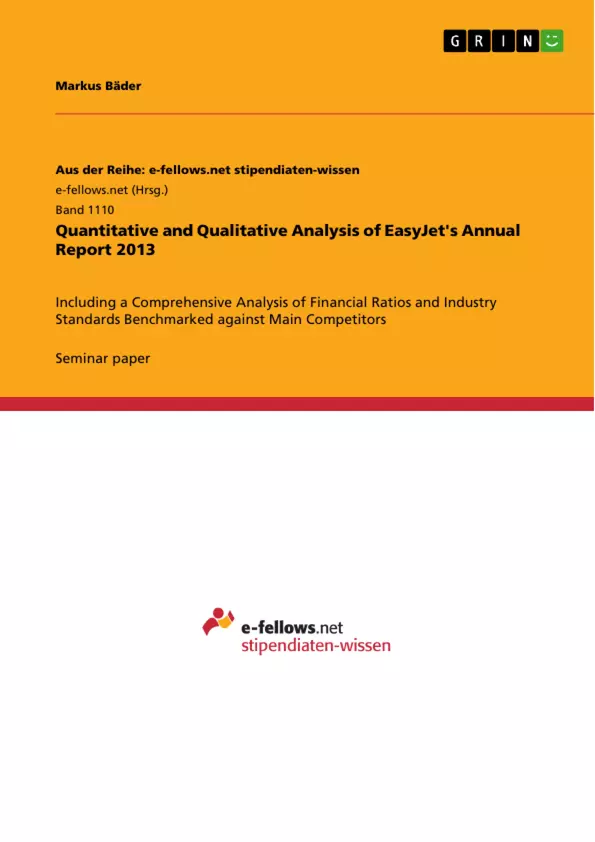Luton-based EasyJet is UK’s largest low-cost airline, employing 8,945 people and carrying 61m passengers annually. EasyJet follows Porter’s low-cost strategy, effectively distinguishing itself from other LCCs by competing against established flag-carriers at primary European airports. The company streamlines its operations to cost-reduction, facilitated by a strong capital structure.
Europe’s airline industry has experienced a structural change since the recession in 2009, with major legacy-carrier continuously reducing their short-haul-capacity. Simultaneously, a KPMG study revealed that the cost gap between traditional and budget airlines has recently shrunk by 30%.
EasyJet’s business model distinctly differs from LCC-pioneer Ryanair as the Irish have strategically built a route network focused on serving secondary airports and thereby managed to keep the cost per seat 50% below EasyJet. However the Britons cost-control strategy resulted in a 48% favourable cost base compared to competing legacycarrier such as IAG.
Table of Contents
- Part A: Financial Performance
- Introduction
- Internal Analysis
- External Analysis
- Financial Analysis
- Operational Performance
- Profitability
- Short-Term Liquidity
- Long-Term Solvency
- Stock Market
- Conclusion
- Recommendation
- Part B: Corporate Communication
- Introduction
- Evaluating the Use of Graphs
- Conclusion
Objectives and Key Themes
This analysis aims to evaluate EasyJet's business performance in Financial Year 2013 (FY13), focusing on both its financial health and corporate communication strategies. The analysis utilizes a combination of internal and external analyses to assess EasyJet's position within the market.
- EasyJet's financial performance and profitability
- Analysis of EasyJet's low-cost business model and its effectiveness
- Evaluation of EasyJet's liquidity and solvency
- Assessment of EasyJet's stock market performance
- Examination of EasyJet's corporate communication, specifically the use of graphs.
Chapter Summaries
Part A: Financial Performance: This section provides a comprehensive analysis of EasyJet's financial performance during FY13. It begins with an introduction to EasyJet's business model, highlighting its low-cost strategy and competitive positioning within the European airline market. Internal and external analyses are conducted to assess the company's strengths, weaknesses, opportunities, and threats. The core of this part delves into a detailed financial analysis, covering operational performance, profitability, short-term liquidity, long-term solvency, and stock market performance. Each aspect is thoroughly examined using relevant financial ratios and comparisons to competitors. The section concludes with a summary of EasyJet's overall financial performance and recommendations for improvement.
Part B: Corporate Communication: This part focuses on evaluating the effectiveness of EasyJet's corporate communication strategies, particularly the use of graphs and visual representations of data. It analyzes how these communications convey information to stakeholders, such as investors and the public. The analysis assesses the clarity, accuracy, and persuasiveness of the presented information and explores the impact of such communications on public perception and investor confidence. The chapter likely concludes by summarizing the findings and offering suggestions for improvement in EasyJet's communication methods.
Keywords
EasyJet, low-cost carrier (LCC), financial performance, profitability, liquidity, solvency, stock market, corporate communication, financial analysis, SWOT analysis, competitive advantage, Porter's generic strategies, Return on Capital Employed (ROCE), Free Cash Flow (FCF), Price Earnings Ratio (P/E Ratio).
EasyJet Financial Performance and Corporate Communication Analysis: FAQ
What is this document about?
This document is a comprehensive preview of an analysis evaluating EasyJet's business performance in Financial Year 2013 (FY13). It covers both EasyJet's financial health and its corporate communication strategies, utilizing internal and external analyses to assess its market position.
What are the main parts of the analysis?
The analysis is divided into two main parts: Part A focuses on EasyJet's financial performance, including operational performance, profitability, liquidity, solvency, and stock market performance. Part B evaluates EasyJet's corporate communication strategies, particularly the use of graphs and visual data representation.
What aspects of EasyJet's financial performance are analyzed?
The financial performance analysis covers operational performance, profitability (using ratios and comparisons to competitors), short-term liquidity, long-term solvency, and stock market performance. The analysis uses a combination of internal and external analyses to assess EasyJet’s strengths, weaknesses, opportunities, and threats.
How is EasyJet's corporate communication evaluated?
The evaluation of EasyJet's corporate communication focuses on the effectiveness of its use of graphs and visual data representation in conveying information to stakeholders (investors and the public). The analysis assesses the clarity, accuracy, and persuasiveness of the information presented and its impact on public perception and investor confidence.
What are the key objectives of this analysis?
The analysis aims to evaluate EasyJet's overall business performance in FY13, focusing on its financial health and corporate communication strategies. It seeks to understand the effectiveness of its low-cost business model and its communication methods.
What are the key themes explored in this analysis?
Key themes include EasyJet's financial performance and profitability, its low-cost business model, liquidity and solvency, stock market performance, and the effectiveness of its corporate communication, particularly the use of graphs.
What methodologies are used in the analysis?
The analysis uses a combination of internal and external analyses, financial ratios, comparisons to competitors, and an examination of EasyJet's corporate communication materials.
What are some of the key financial metrics analyzed?
Key financial metrics likely include Return on Capital Employed (ROCE), Free Cash Flow (FCF), and Price Earnings Ratio (P/E Ratio).
What are the key takeaways from this preview?
This preview provides a structured overview of the EasyJet analysis, outlining the scope, methodology, and key findings to be expected in the full report. It highlights the comprehensive nature of the study, covering both financial and communication aspects of the business.
What are the keywords associated with this analysis?
Keywords include EasyJet, low-cost carrier (LCC), financial performance, profitability, liquidity, solvency, stock market, corporate communication, financial analysis, SWOT analysis, competitive advantage, Porter's generic strategies, Return on Capital Employed (ROCE), Free Cash Flow (FCF), and Price Earnings Ratio (P/E Ratio).
- Citar trabajo
- Markus Bäder (Autor), 2015, Quantitative and Qualitative Analysis of EasyJet's Annual Report 2013, Múnich, GRIN Verlag, https://www.grin.com/document/288365



